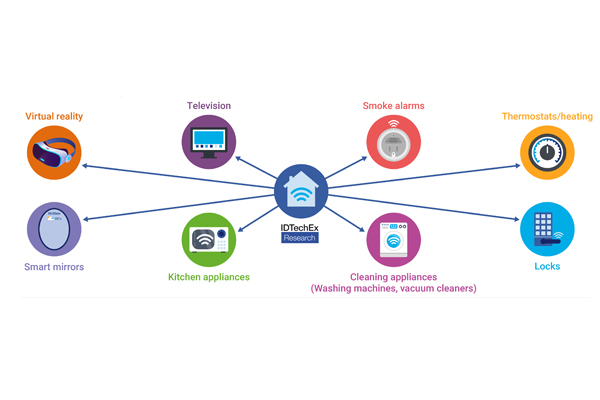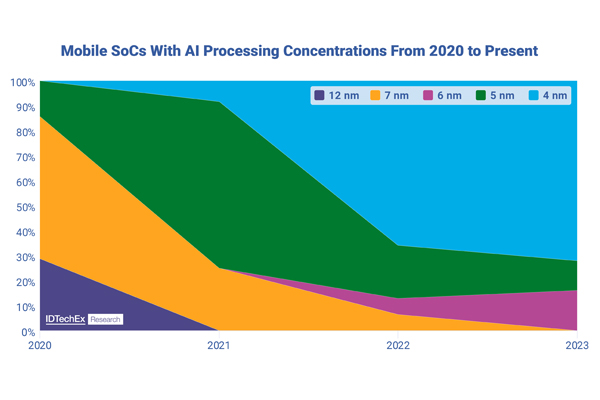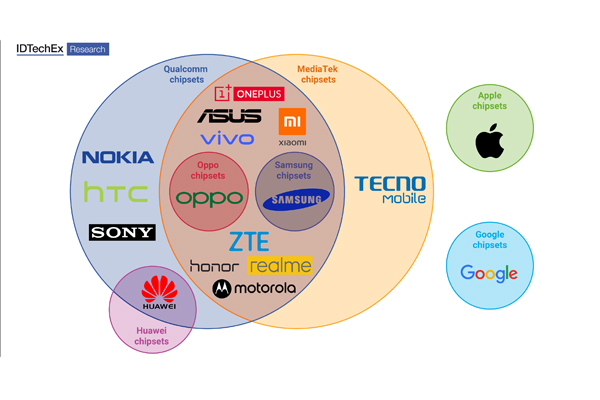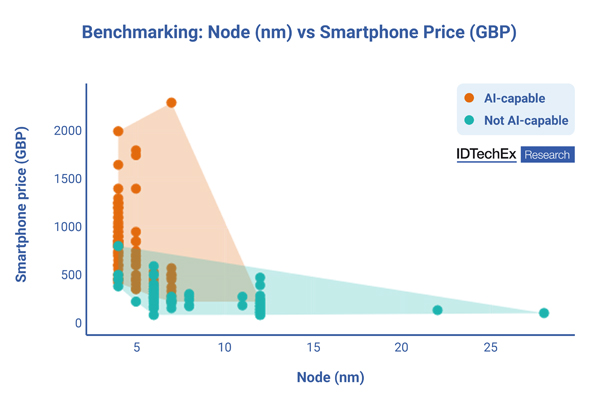IDTechEx's market research report, "AI Chips for Edge Applications 2024-2034: Artificial Intelligence at the Edge," projects that the global AI chips market for edge devices will grow to US$22 billion by 2034, with the consumer electronics industry vertical taking the largest chunk of this revenue figure, at just over 45 percent by this date.
AI has already seen significant adoption in smartphones, tablets, smart speakers, personal computers and televisions, with a projected increase in the rollout of AI chips to edge devices within the home in order to facilitate a local Internet of Things over the next few years being significant to the way people's homes are structured and how they interact with their immediate surroundings. To get a sense of where AI is heading when it comes to consumer electronic products, it is informative to consider AI in smartphones, as the smartphone market has already started to saturate, and so the uptake of AI is necessarily limited by this saturation.
Duopoly
The mobile chipset landscape is highly concentrated, with there being the duopoly of Qualcomm (an American company) and MediaTek (a Taiwanese company), who provide system-on-chips (SoCs) to many mobile device manufacturers, as well as Apple and Google, who design their own chipsets for their devices. Two chipset designers of particular note in relation to market consolidation from the below graphic are Samsung and Oppo.

In previous generations of the Samsung Galaxy smartphone, Samsung had employed the Samsung Exynos, a SoC designed by System LSI, a subdivision of Samsung. Conversely, Samsung's smartphone business is managed by the Mobile eXperience (MX) division. The Elec reported in December 2022 that an application processor development team had been set up within the MX division, which could possibly usurp the role that System LSI have thus far played in providing chipsets for Galaxy smartphones. This came on the heels of reports that Samsung would be discontinuing the Exynos line of chipsets, a claim that – while appearing to be premature – was lent credence when, in February 2023, the latest Galaxy smartphone, the S23, was unveiled. This flagship smartphone incorporates a Qualcomm Snapdragon 8 Gen 2 for Galaxy chipset (a custom piece of silicon for the Galaxy phones), dispensing with Exynos chips for the first time. For the time being, Qualcomm are providing chipsets for Samsung flagship smartphones, with the future of Exynos and proprietary Samsung mobile chipsets unclear.
Moving North from South Korea into China, On May 12, 2023, it was reported that Oppo – China's leading smartphone maker – had made the decision to "shut down its semiconductor division (named Zeku) and cease development of its own chips," according to Nikkei Asia. Zeku was set up in 2019 for the purposes of designing chips for Oppo devices, following a similar business model to that employed by Huawei and Xiaomi.
The closure of Oppo's chip design division has come about due to a mixture of tighter margins on smartphone production and U.S. restrictions on the use of chips and/or SME that utilize U.S.-origin IP. With Oppo no longer producing their own chips, it appears likely that they will default to incorporating Qualcomm and/or MediaTek chipsets in their future smartphones, given that these are the market leaders for mobile chipsets.
Traditionally, Qualcomm has been effective at cornering off the flagship end of the smartphone market, while MediaTek has come to dominate the low- to mid-range smartphone offering. However, there are signs that the status quo may be disrupted over the coming years, as MediaTek have entered into the flagship space with their Dimensity 9000, Dimensity 9200 and most recently, their Dimensity 9200+ chipsets.
Premiumization
In 2022, approximately 1.2 billion smartphones were shipped globally, a decrease of around 10 percent from the number of smartphones shipped in 2021, which is evidence of the fact that smartphone saturation has occurred in numerous national markets (where the onus to upgrade a smartphone every couple of years to the latest offering is not so keenly felt).
Not all of these 1.2 billion smartphones include chipsets that have AI coprocessing capabilities. To get a sense of the proportion of these chipsets that incorporate AI coprocessing, it is worth considering the bestselling models and how their volume of sales contributes to the total annual sales figure.
The ten bestselling smartphone models of 2022 (most of which are Apple smartphones, the rest Samsung) account for approximately 20 percent of global sales. Of the Apple smartphones, the oldest chip present in these models is the A14 Bionic, which has a neural engine (as do all subsequent Apple smartphone chips). Of the Samsung smartphones, neither of the bestselling models has a dedicated AI acceleration component to their chipsets. As such, out of this 20 percent of global sales, smartphones with AI coprocessing account for approximately 17 percent, and smartphones without AI coprocessing account for 3 percent.

Applying these proportions to the total of 1.2 billion smartphones for 2022 would be erroneous, as several other factors need to be considered. The first is that the smartphone market is in decline, and 2022 saw smartphone vendors cull some of their less profitable models so as to create a smaller portfolio as a means to increase profitability via volume (flagship models cater to more developed smartphone markets, whereas the cheapest models are a means of increasing market share in developing markets).
The second is the evolution of smartphone sales in developing markets. Already developed markets – such as North America and much of Europe, for example – have nowhere to go in terms of smartphone movement from low to high end, as these regions already account for much of the premium smartphone market. However, developing markets will naturally move from the low to high end as their economies grow. This is supported by the increasing share of the sale of premium smartphones to total sales (known as premiumization), even while the overall smartphone volume decreases.
As premium smartphones tend to almost entirely have AI acceleration incorporated into their chipsets now, it stands to reason that the use of AI in smartphones will grow by volume compared to chipsets that do not incorporate AI coprocessing. The ultimate ceiling, however, has already presented itself through the saturation of the smartphone market. The share of smartphone chipsets that incorporate AI coprocessing may take some years to increase to the level of saturation, but trends suggest that this movement is inevitable, with the growth of AI in smartphones providing a valuable model for AI adoption in other consumer electronic products.
Report Coverage
IDTechEx forecasts that the global AI chips market for edge devices will grow to US$22.0 billion by 2034, with AI chips for consumer electronics accounting for more than 45 percent of this figure. IDTechEx's report gives analysis pertaining to the key drivers for revenue growth in edge AI chips over the forecast period, with deployment within the key industry verticals – consumer electronics, industrial automation and automotive – reviewed. Case studies of leading AI accelerators and SoCs for smartphones, tablets and other consumer electronic devices are given, as are key trends relating to node process and device price.
More generally, the report covers the global AI Chips market across eight industry verticals, with 10-year granular forecasts in six different categories (such as by geography, by chip architecture and by application). IDTechEx's market research report, "AI Chips for Edge Applications 2024-2034: Artificial Intelligence at the Edge," answers the major questions, challenges and opportunities the edge AI chip value chain faces.

